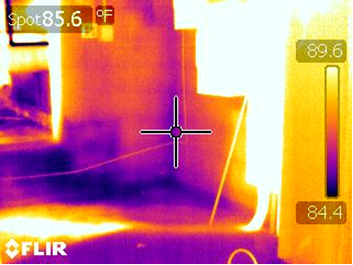With the recent storms and heavy rains, my Rand coworkers and I have been extra busy conducting leakage evaluations. To assist us in our investigations, we've been incorporating infrared technology.
An infrared camera has a sensor that detects temperature differences in the area being photographed and shows them as different colors. When water evaporates it cools, and the cooler areas appear as purple in the infrared images. We then visually inspect those locations to confirm that there is, in fact, water present.

The dark purple areas in this infrared photo indicate cooler spots, where water was leaking in.
Since taking a certification course in infrared building investigations a few weeks ago, I've been using the infrared camera more and more and it's been very helpful. For example, at one building where I was investigating leaks, water had damaged elevator electrical equipment, ceilings, and walls. As I would normally do, I went on the roof to look for any obvious issues that could be causing the leaks. I saw a bunch of problems: ponding (puddles), a blistering roof membrane, and missing counterflashing (a metal strip that keeps water from entering between the edge of the roofing membrane and the parapet wall).
Although the roof defects looked like they were contributing to the leaks in the elevator room (above photo), they didn't appear to be the cause of the water damage in a bathroom and bedroom several floors below. Based on the location of the damage, one possibility was that water was leaking from behind the elevator shaft. I took several infrared photos of the elevator shaft to see what might appear. Sure enough, there were streaky purple areas in the image (below), which indicated that water was running down the shaft and into the bathroom and bedroom with the affected areas.

The infrared camera detected water (purple) behind this elevator shaft, helping pinpoint the source of the leaks, confirmed through an investigative probe.
To confirm that it was a leak we were seeing in the infrared photo, and to figure out where it might be coming from, I asked the contractor to conduct an investigative probe into the bathroom wall on the 14th floor. When we opened up the wall we saw a crack in the hub on a plumbing riser, which was overflowing with water. The water was then traveling down from floor to floor through the riser penetrations, ending up at the 11th floor bathroom ceiling, where the damage was evident.
Thanks to the infrared images, we were able to pinpoint the source of the leak more quickly than if I conducted just a visual survey. Plus, we needed to conduct only one investigative probe instead of several, so we saved our client both time and money.
The infrared technology is not a miracle tool, of course. You still have to perform a visual examination to confirm that the purple spots are water related and possibly use a moisture meter and conduct investigative probes when necessary. Some spots that appear as purple in the infrared photos may not be water—they could be cooler areas caused by drafts or missing insulation, for example. But even in those cases, the infrared camera helps point out heat and energy losses that should be looked at.
The infrared camera that Rand uses (FLIR ThermaCAM T300) is not cheap—it cost $8,300 (which, adding in the cost of the training, led Rand's president to joke about the leaks in Rand's expenses). But given the number of leakage investigations that Rand does and the advantage we think the camera provides, we see it as a worthwhile investment that will pay off for us and for our clients. I'm now taking my Level II thermography training and looking forward to learning advanced diagnostic techniques, which I will write about in a future post.
If your building has had a leak investigation using an infrared camera, I'd be interested in hearing how it went, so please leave a comment below. I'm also happy to answer any questions you have on the technology, so feel free to contact me at info@nullrandpc.com.

2 Responses to Infrared Eye for Detecting Leaks